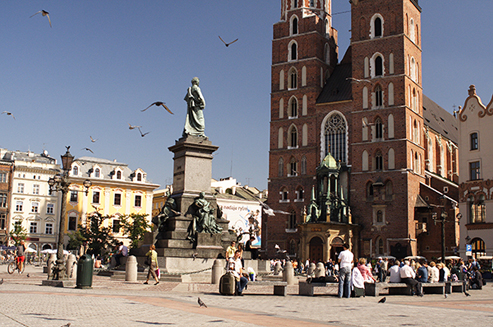Cracow is a gem among Polish towns. Its presence in the UNESCO’s World Heritage List is a significant testimony to the value of the age-old history of this city.
Cracow is known as the spiritual and cultural capital of Poland. It has a unique charm of a place whose history is hidden in stones, walls and monuments of its former glory.
This is what we find in any guidebook, brochure or web entry. Yet, are we ready to start a truly magical journey around ancient Cracow? Are we ready to take a risk and see the town in which “the gates of time” open and invite us to extraordinary places, age-old buildings, mysterious squares and charming streets? This is where the stones tell unusual stories and recall important events.
The magic of the Wawel Chakra, one of the seven stones of energy which constitute the basis of the Earth, allows to recall legendary and historic personas and their stories about the events and places which have changed over time.
The legend about the Dragon of Wawel hill and King Krakus, pagan mounds and a mysterious statue of the Zbruch Idol transfer us to the world of beliefs and traditions from before twelve hundred years.
Interiors of Romanesque and Gothic churches, tombs of former rulers and bishops, sculptures and artefacts hidden in treasuries and museums definitely change our idea of the gloomy Middle Ages.
Noble walls of Alma Mater of Collegium Maius testify to the power of science and the effort with which people used to discover the secrets of the world. Unusual scientific devices, numerous studies and theses, portraits of professors and benefactors gathered in the Jagiellonian University Museum remind us about alchemic experiments, astronomic observations, and studies of nature or historic theories which have been enriching our knowledge for ages.
The Wawel Royal Castle, the Renaissance residence of Polish kings, moves us in time to the “golden age of Cracow”. The Jagiellonian dynasty was one of the most powerful royal families in Europe, and Cracow was a modern, rich and internationally famous town at that time.
The Wawel collections, including the Jagiellonian tapestries of king Sigismund II Augustus, Renaissance paintings, such as Leonardo da Vinci’s “Lady with an Emine”, and the Sigismund’s Chapel of the Wawel Cathedral will delight everyone who wants to see the top art pieces.
Cracow is the only place in which you can see the massive walls of Romanesque churches side by side with soaring towers of Gothic basilicas and magnificent Baroque temples.
Naves, aisles and chapels of all these churches are filled with altars, holy paintings and sculptures. There are also relics and tokens of saints and blesseds, tombs and sarcophagi, as well as epitaphs with the names of former rulers, bishops and citizens of Cracow.
Historical buildings of Cracow stand side by side with modern multimedia museums – Rynek Underground under the Main Square, Schindler’s Factory, Gallery of 19th Century Polish Art at Sukiennice – which will take you in an unforgettable journey in time and space.
If you get tired with strolls along the beautiful streets and tourist routes of Cracow, visiting exhibitions of over 50 museums, 200 churches and watching numerous old tenement houses and palaces, then the Old Town, surrounded with a green ring of the Planty Park, offers you hundreds of cafes, restaurants, pubs, shops and crafts shops which built up the unique atmosphere of Cracow. Cracow bagels (obwarzanki), maczanka dip and other specialties of Polish cuisine are just examples of rich and old traditions which originate from the famous feast (The Congress of Cracow) which Casimir III the Great organised for other kings and dukes.
The centre of the town is easily accessible thanks to the modern international airport, convenient train connections, and a well-developed network of transit roads. Numerous hotels and guesthouses offer good prices, elegant interiors and professional service.
Before you decide to visit Cracow, remember that since the Middle Ages the town has been casting a magical spell on its guests, thanks to which they become its best ambassadors.
Cracow is the town of noble past, colourful present and bold future.
See pictures gallery ©Francesco Carovillano
Photo © Anna Karahan


